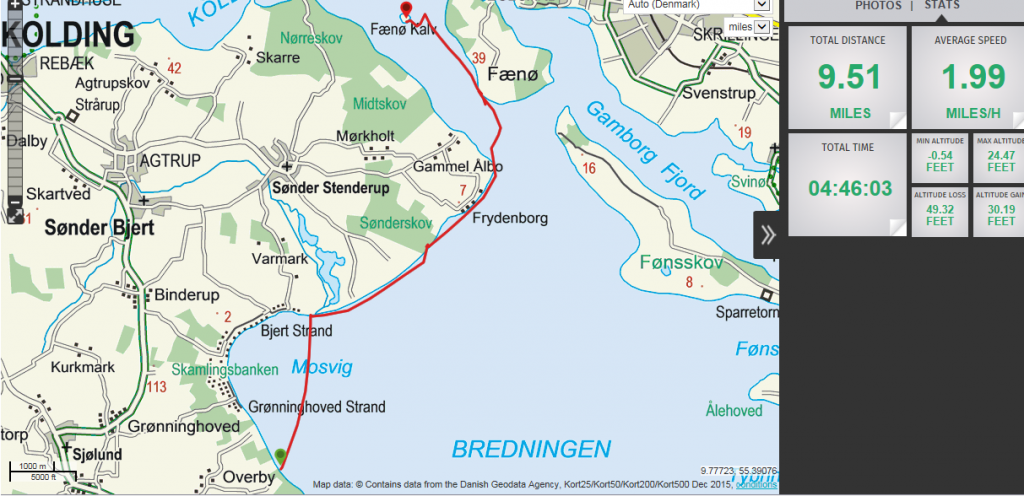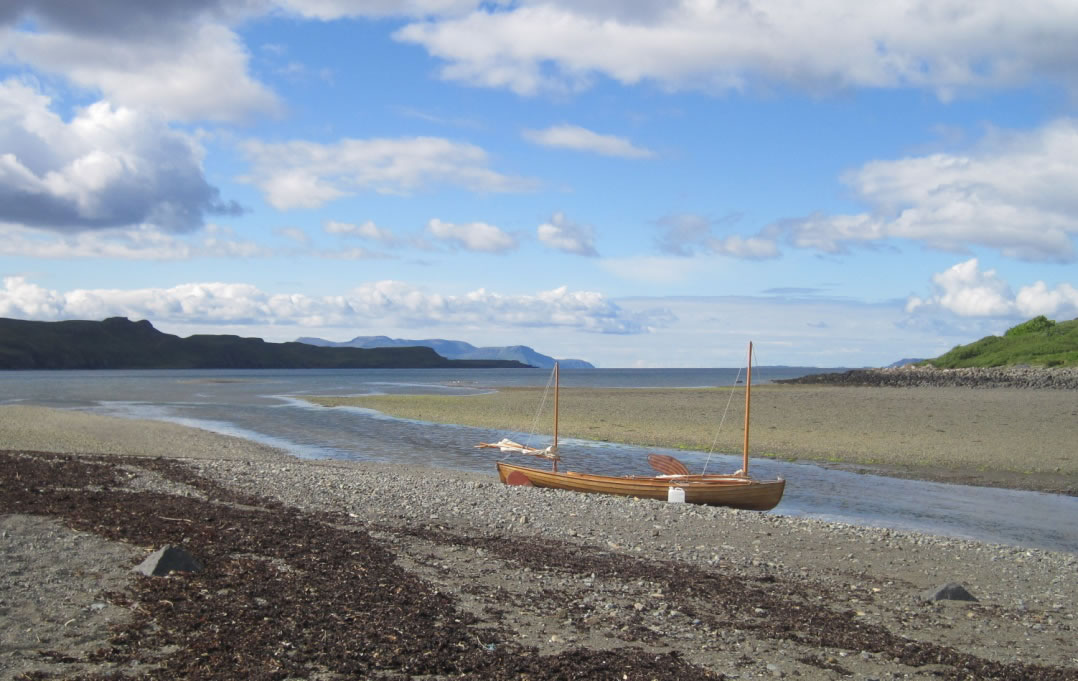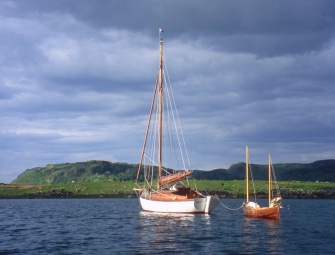Week 2: The Little Belt
Copenhagen is a well connected city and hence ideal for crew changeover. we took a ferry from Aarhus and drove to a campsite at Roskilde which is conveniently near the capital. Barbara, William and Pat were due to arrive and join me for Week 2 of the cruise, with a full day of overlap before Jon and Greg flew out, so we took the opportunity to visit the Viking Ship Museum which is at Roskilde.

From there we drove down and across the ferry at Bojden and on to a campsite at Nederby on Flensburg Fjord to begin the second week.

Overview of week 2 tracks and camping places
Day 1 Mon 31/07/2017 – 15.9 miles


We got away from the campsite by 12.00. The wind was blowing force 3-4 from the West. Barbara, helming the newer canoe, wisely chose to reef immediately, before leaving the shelter of the bay near the campsite and heading over towards Holnis Point on the German shore.
Unfortunately she failed to notice that the rudder blade was not fully down. The long fetch and some adverse current combined to kick up quite a sea in mid channel. The corkscrew motion of the quartering waves was hard to manage without the benefit of the full rudder area and they capsized shortly before reaching the point, but soon had the canoe up again and bailed out.
We all enjoyed a rest in the sunshine on the beach.
Onwards again after lunch on a long run across the mouth of a bay to a spit on the Southernmost point of the Danish shore. It was quite rough again near the spit and Barbara reduced sail to mizzen only, set aft. We stopped for a brew in the shelter of the spit and reset the mizzen masts in both canoes forward of the centreboard case, but without lowering the foremasts.
Under this rig we continued, turning gradually North around the land and gaining much more shelter from the waves.
We crossed the open Vemmingbund to reach the shore just West of Sonderborg entrance
and camped on a beach below a designated “overnatning” tent site which we felt was unfortunately too hard to reach from the water with all our gear.
Day 2 Tues 01/08/2017 – 7.2 miles


We were camped very close to Dybbol Banke, the site of the famouse Danish last stand against the Prussians in 1864, a visit to which seemed to feature in every cruise account of the area that I had ever read. So we walked along the coast and up to the remains of the fortifications and visited the museum, which was well worthwhile. What a waste of Danish and Prussian lives.

We had a very slow sail in light airs to Sonderborg and moored up agaisnt some wide public steps, right by the Danish royal yacht where the harbour wall was lowest.

Tea and cakes in a cafe by the bridge and then back to the canoes and paddled under the bridge and up Als Sund to find a nice quiet location to camp on the Eastern shore where there was an abandoned picnic bench.

However it was not as peacful as we had hoped, waterskiers seem to use this stretch of the sound in the evening and a pilot practicing repeated takeoffs and landings in a seaplane. They all went home in the end when the light faded.
Day 3 Weds 02/08/2017 – 18.2 miles

A fine morning with a moderate Southwesterly wind. We were quickly out into the more open Als Fjord and on a reach up towards the Northern end.
Stopped twice in the shelter of the mainland shore, then emerged to cross the exposed mouth of the Aabenraa Fjord under reefed main and mizzen to try and get as far as possible while the weather held.
Stopped again on the other side in a nice bay and then on for another mile or so to a public campsite on the foreshore to refill the water containers and buy an ice cream.
From here we ran downwind in bright sunshine across to the island of Barso and on around it to camp in a field at the Northern end
with a view out over a wide expanse of open sea to the North which we hoped to cross the next day. The camping place was perfect except for some frisky cattle who took more interest in us than we wanted.
A fine campfire used to good effect to roast some aubergines and peppers in tinfoil for supper.
Day 4 Thurs 03/08/2017 – 12.8 miles

Steady rain whilst striking camp and a South wind of about force 4. We could not see the shore 4 miles away to the North so had to start out, under reefed sail, on a compass bearing. The seas built up once we were out of the shelter of the island. We were making 5 knots, but Barbara, helming the old canoe, finally felt that she had to lower the foresail to avoid the risk of a capsize, so I did the same. I actually found it harder to balance under this rig with such a corkscrewing sea from the stern quarter, as there was not much weight of wind in the sails to balance against.

We felt rather exposed yet it was hard to get the two canoes to go at a compatible speed and so stay close together enough to be of assistance should one capsize. Nearing the far shore, the waves were particularly large but there was no obvious sheltered spot in which to stop, so we plugged on along the lee shore towards the Northwest until we could finally round Halk Hoved and find a suitable place.
The rest of the trip to Arosund was in easier conditions and we arrives by 12.15pm 3/4hour before the wind was forecast to rise to 18 knots!

We stopped on a small beach just beyond the mainland harbour. It poured with rain and no one seemed to be about as we explored the place on land. We fancied a touch of luxury and a place to dry out our wet camping gear but the only hotel was fully booked, or so they said when they had taken a look at us! We had to be content with fish and chips in a fairly basic transport cafe near the ferry. At least it was warm.
We were reconciled to night in the open fronted “overnatning” hut. This was not in fact at all bad, particularly if one is exhausted!
Later the sun came out and we got tokens for the hot showers and clothes dryers at the marina. There appeared to be no shops, so we walked 1 mile to a nearby campsite which yielded a small supermarket from which to restock.
In the evening a friendly couple from the local rowing club came and chatted to us in our hut and offered hospitality and any assistance we might require.
Day 5 Fri 04/08/2017 – 10.3 miles

We could now work up the coast in relative shelter from the Southwest wind which was forecast to be about 12 knots but which rose more and more until it was about 20 knots ( force 5) by the time we reached the area of “free tenting” woodland where we planned to camp at about 3pm.

We started out under reefed main and mizzen, then mizzen only ( set aft), then mizzen only forward ( for the more open bay off Hejlsminde) and finally just paddled as the wind was too gusty when near enough to the shore to get enough shelter.

Later in the day the sun came out and the wind reduced and we had a pleasant time relaxing on the beach in good shelter. It was a nice place to camp but the serenity was slightly marred by noise from a house, which we had not noticed at first, hidden up in the trees close behind the beach.

Day 6 Sat 05/08/2017 – 9.5 miles

Less wind today , about force 4 from the West. Started under reefed main and full mizzen and cut straight across Mosvig bay on the most comfortable course we could in order to avoid either too much fetch or too gusty a wind. However, it was still rough enough by the time we reached the far shore. Beached in rather an exposed spot then walked the canoes round a small spit into the mouth of a stream to get some shelter from the waves.
On along the shore to the Northeast in surprisingly shallow water (9-12inches deep) on a broad reach. The extensive shallows gave useful shelter from the remaining Southerly swell, which broke further out. We shocked a lone, snorkelling, spear fisherman right in our path, who was not expecting anyone to creep up on him so quickly in such a depth!
The sun came out and we stopped for lunch at a picnic table in the woods set on a slightly raised grassy section near a designated “overnachtning” place which would be a fine campsite.

I got Pat to helm us under paddle and then under mizzen only. We rounded the corner and headed up towards Faeno Kalv island, now with a gusty wind hard on the Port bow. At one point William and Barbara, in the other canoe, shot past us and it became obvious that the sound had a strong current flowing out to the Southeast and causing tidal swirls.
Went ashore on Faeno as making no progress at all against the current. Increased sail to reefed main and mizzen to get more power. Pat had a nail-biting beat against tide and the gusty wind, with me hanging right out at times, before reaching the island. Barbara and William elected to paddle along close to the Faeno shore.

It was a lovely, if rather busy, place to camp. We were kept awake by some late night revellers and by a group of torchlight canoeists from Middlefart who warned us of even stronger currents to come, nearer the town.
Day 7 Sun 06/08/2017 – 9.1 miles approx

Up and away by 9am as , according to the canoeists the previous night, the current is less severe early and late in the day. Sailed to Middlefart with no problems in a following wind from the West.
Moored up in a small dock near a traditional boatbuilders which was established in the 1880s. We visited a craft fair which happened to be running and a small boat museum of some interest.
After a cup of coffee in town we set off under full sail to reach across the strong ‘wind over tide’ standing waves towards the more sheltered Northern shore, but William and Barbara were capsized in midstream. The mizzen came out of its socket and Williams jar of hand-cream floated away downwind. We did a quick “hand-cream overboard” exercise and then kept station nearby while Barbara bailed out. William kept the canoe as stable as he could in the waves from a position in the water leaning on the lee side of the canoe near the centreboard. He found that the best way to do this was not to heave-to as usual but to sheet in the foresail in order to provide some counterbalance to his weight and keep the tiller locked straight ahead as if actually sailing the canoe through the water.
when they had bailed out we headed over to a convenient marina on the North shore to regroup. William’s phone had unfortunately expired in the incident, despite a waterproof bag.

From here we finished with a gusty session fairly hard on the wind , under the main road bridge and up the Western shore to a slip at the marina near Fredricia where we planned to finish and catch the train back to get the van.








































































































































































































































